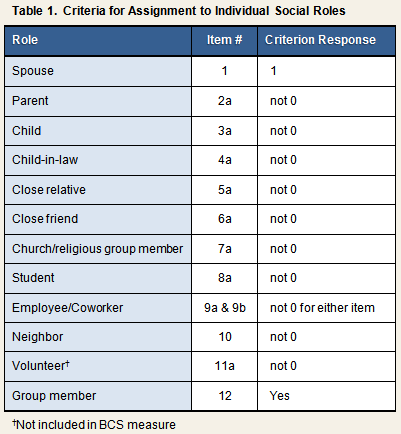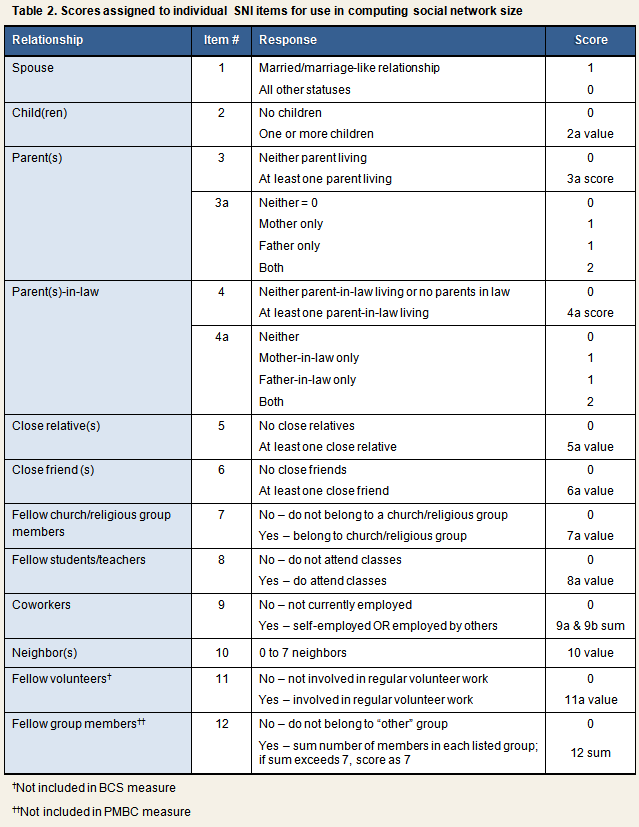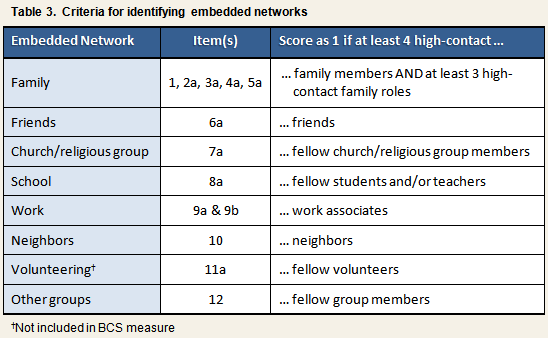Social Integration and Network Size
Title
Studies
BCS, PCS1, PCS2, PMBC, PCS3
Copyright Information
Copyright is owned by Dr. Cohen
Primary Reference
1. Cohen, S., Doyle, W. J., Skoner, D. P., Rabin, B. S., & Gwaltney, J. M. (1997). Social ties and susceptibility to the common cold. The Journal of the American Medical Association, 277, 1940-1944.
Purpose
To assesses participation in 12 social relationships (Note: BCS only evaluates 11 relationships, as it does not include the volunteer role). These include relationships with a spouse, parents, parents-in-law, children, friends, workmates, etc. The Index measures three aspects of social networks: network diversity, number of people in the network, and number of embedded networks. Belonging to diverse social networks is associated with less susceptibility to infection1, lower mortality, and cancer survival3.
Description
Participants indicate participation in 12 social relationships (11 in BCS) and report how many members of these relationships they communicate with at least once every 2 weeks.
Scaling
N/A
Number of Items
12 (11 in BCS)
Sample Items
- How many children do you have?
- How many of your children do you see or talk to on the phone at least once every 2 weeks?
- Are either of your parents living?
- Do you belong to a church, temple, or other religious group?
Psychometrics
N/A
Scoring
Number of High Contact Social Roles (Network Diversity/Social Integration)
This measure assesses the number of different types of high contact social roles in which individuals participate. High contact roles are defined as those in which the respondent reports engaging at least once every two weeks. Accordingly, for an individual to be assigned the role of “parent” he or she must have endorsed a response of at least one to item 2a – How many of your children do you see or talk to on the phone at least once every 2 weeks? Simply reporting that one has children (i.e., response of at least one to item 2) is necessary but not sufficient for being assigned to the parent role. Table 1 outlines the criteria used for determining assignment to each of the 12 (11 for BCS) possible social roles. Total network diversity is computed as the sum of all high contact roles.

Number of People in Social Network (Social Network Size)
The SNI operationalizes individuals’ social networks as being comprised of the people with whom individuals interact within the context of their major social roles (see High Contact Social Roles, above). Accordingly, social network size is computed as the sum of all individuals with whom an individual has contact at least once every two weeks. Table 2 presents the scores assigned to individual items for use in computing the total number of people in one’s social network.

| ANALYSIS NOTE |
| Because modifications have been made to the Social Network Index (SNI) since it was first published, scores derived from each of the five studies are not equivalent. For example, the BCS did not include volunteer as one of the social roles. To obtain a social integration score that is equivalent to that of the other 4 studies, the BCS score should be multiplied by 1.09. Also, the SNI item inquiring about the number of "other group" members with whom individuals interact at least once every 2 weeks typically is presented as an open-ended question. Because individuals may interpret this item in multiple ways, values can range from 0 to 100+ fellow group members. To ensure that social network size scores are not artificially inflated by the reporting of large group memberships, we recoded the variable so that all values >6 are given a score of 7, thus keeping it consistent with all other quantitative SNI items. |
Number of Embedded Networks

Variables
- Network Diversity/Social Integration
- Social Network Size
- Embedded Networks
Additional References
2. Cohen, S., & Lemay, E. (2007).Why would social networks be linked to affect and health practices? Health Psychology, 26, 410-417.
3. Helgeson, V., & Cohen, S. (1996). Social support and adjustment to cancer: Reconciling descriptive, correlational, and intervention research. Health Psychology, 15, 135-148.
4. Sneed, R., Cohen, S., Turner, R. B., & Doyle, W. J. (2012). Parenthood and host resistance to the common cold. Psychosomatic Medicine, 74, 567-573.